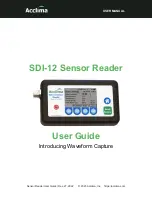
©
2015–2022
Onset
Computer
Corporation.
All
rights
reserved.
Onset,
HOBO,
HOBOconnect,
and
HOBOlink
are
registered
trademarks
of
Onset
Computer
Corporation.
App
Store,
iPhone,
iPad,
and
iPadOS
are
service
marks
or
registered
trademarks
of
Apple
Inc.
Android
and
Play
are
trademarks
of
LLC.
Windows
is
a
registered
trademark
of
Microsoft
Corporation.
Bluetooth
and
Bluetooth
Smart
are
registered
trademarks
of
Bluetooth
SIG,
Inc.
All
other
trademarks
are
the
property
of
their
respective
companies.
Patent
#:
8,860,569
26456
‐
A
1
‐
508
‐
759
‐
9500
(U.S.
and
International)
1
‐
800
‐
LOGGERS
(564
‐
4377)
(U.S.
only)
www.onsetcomp.com/support/contact
Maintenance
To
clean
the
soil
moisture
sensor
and
needles,
use
a
mild
detergent,
such
as
liquid
dish
soap,
and
a
nonabrasive
sponge
or
cloth.
Avoid
detergents
that
contain
lotions
or
moisturizers.
Rinse
the
sensor
and
needles
thoroughly
with
tap
or
deionized
(DI)
water.
The logger is designed for outdoor use, but should be
inspected periodically. Wipe off any dust or grime with a damp
cloth.
Troubleshooting
If
the
soil
moisture
sensor
readings
are
too
low
or
slightly
negative,
check
for
air
gaps
around
the
sensor
needles.
These
could
be
produced
below
the
surface
of
the
substrate
when
the
needle
contacts
a
large
piece
of
material
and
pushes
it
out
of
the
way,
or
if
the
sensor
is
not
inserted
perfectly
linearly.
If
the
sensor
readings
are
too
high,
make
sure
the
media
was
not
packed
excessively
or
insufficiently
during
sensor
installation.
Higher
density
can
cause
the
sensor
readings
to
be
elevated.
Battery
Information
The
logger
requires
one
user
‐
replaceable
2/3
AA
3.6
V
lithium
battery
(HRB
‐
2/3AA).
Battery
life
is
2
years,
typical
with
a
logging
interval
of
1
minute,
but
may
be
extended
to
5
years
when
the
logger
is
configured
with
Bluetooth
Always
On
disabled.
Expected
battery
life
varies
based
on
the
ambient
temperature
where
the
logger
is
deployed,
the
logging
or
sampling
interval,
frequency
of
offloading
and
connecting
to
the
mobile
device,
number
of
channels
that
are
active,
and
use
of
burst
mode
or
statistics
logging.
Deployments
in
extremely
cold
or
hot
temperatures
or
logging
interval
faster
than
1
minute
can
impact
battery
life.
Estimates
are
not
guaranteed
due
to
uncertainties
in
initial
battery
conditions
and
operating
environment.
Battery
Replacement
1.
Use
a
Phillips
‐
head
screwdriver
to
unscrew
the
four
screws
from
the
back
of
the
logger.
2.
Carefully
separate
the
top
and
bottom
of
the
logger
enclosure.
3.
Remove
the
old
battery
and
insert
the
new
battery
observing
polarity.
It
is
recommended
that
you
replace
the
desiccant
(DESICCANT2)
when
replacing
the
battery.
4.
Make
sure
the
rubber
seal
is
clean
and
free
of
any
debris
and
then
carefully
reassemble
the
logger
enclosure
and
screw
in
the
four
screws.
WARNING:
Do
not
cut
open,
incinerate,
heat
above
85°C
(185°F),
or
recharge
the
lithium
battery.
The
battery
may
explode
if
the
logger
is
exposed
to
extreme
heat
or
conditions
that
could
damage
or
destroy
the
battery
case.
Do
not
dispose
of
the
logger
or
battery
in
fire.
Do
not
expose
the
contents
of
the
battery
to
water.
Dispose
of
the
battery
according
to
local
regulations
for
lithium
batteries.
Federal
Communication
Commission
Interference
Statement
This
equipment
has
been
tested
and
found
to
comply
with
the
limits
for
a
Class
B
digital
device,
pursuant
to
Part
15
of
the
FCC
Rules.
These
limits
are
designed
to
provide
reasonable
protection
against
harmful
interference
in
a
residential
installation.
This
equipment
generates
uses
and
can
radiate
radio
frequency
energy
and,
if
not
installed
and
used
in
accordance
with
the
instructions,
may
cause
harmful
interference
to
radio
communications.
However,
there
is
no
guarantee
that
interference
will
not
occur
in
a
particular
installation.
If
this
equipment
does
cause
harmful
interference
to
radio
or
television
reception,
which
can
be
determined
by
turning
the
equipment
off
and
on,
the
user
is
encouraged
to
try
to
correct
the
interference
by
one
of
the
following
measures:
Reorient
or
relocate
the
receiving
antenna
Increase
the
separation
between
the
equipment
and
receiver
Connect
the
equipment
into
an
outlet
on
a
circuit
different
from
that
to
which
the
receiver
is
connected
Consult
the
dealer
or
an
experienced
radio/TV
technician
for
help
This
device
complies
with
Part
15
of
the
FCC
Rules.
Operation
is
subject
to
the
following
two
conditions:
(1)
This
device
may
not
cause
harmful
interference,
and
(2)
this
device
must
accept
any
interference
received,
including
interference
that
may
cause
undesired
operation.
FCC
Caution:
Any
changes
or
modifications
not
expressly
approved
by
the
party
responsible
for
compliance
could
void
the
user's
authority
to
operate
this
equipment.
Industry
Canada
Statements
This
device
complies
with
Industry
Canada
license
‐
exempt
RSS
standard(s).
Operation
is
subject
to
the
following
two
conditions:
(1)
this
device
may
not
cause
interference,
and
(2)
this
device
must
accept
any
interference,
including
interference
that
may
cause
undesired
operation
of
the
device.
Avis
de
conformité
pour
l’Industrie
Canada
Le
présent
appareil
est
conforme
aux
CNR
d'Industrie
Canada
applicables
aux
appareils
radio
exempts
de
licence.
L'exploitation
est
autorisée
aux
deux
conditions
suivantes
:
(1)
l'appareil
ne
doit
pas
produire
de
brouillage,
et
(2)
l'appareil
doit
accepter
tout
brouillage
radioélectrique
subi,
même
si
le
brouillage
est
susceptible
d'en
compromettre
le
fonctionnement.
To
comply
with
FCC
and
Industry
Canada
RF
radiation
exposure
limits
for
general
population,
the
logger
must
be
installed
to
provide
a
separation
distance
of
at
least
20cm
from
all
persons
and
must
not
be
co
‐
located
or
operating
in
conjunction
with
any
other
antenna
or
transmitter.
Unscrew
these
four
screws
to
replace
the
battery



























